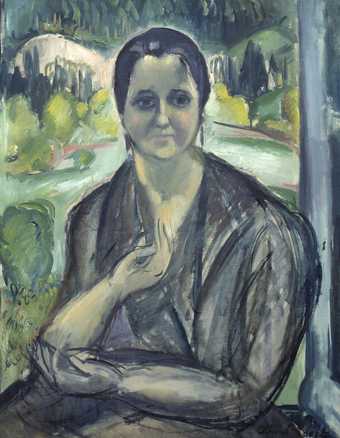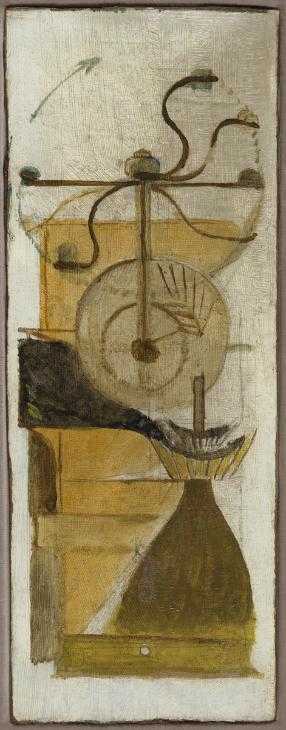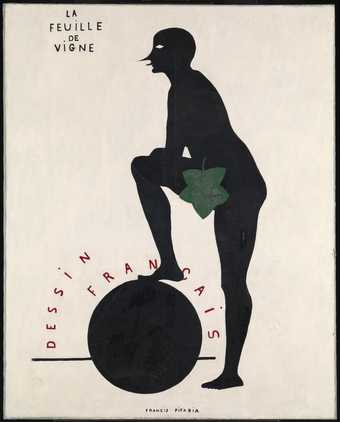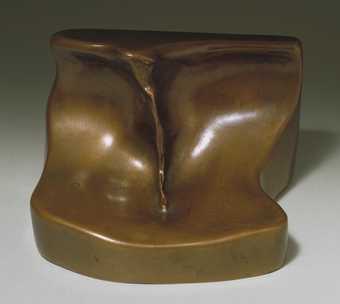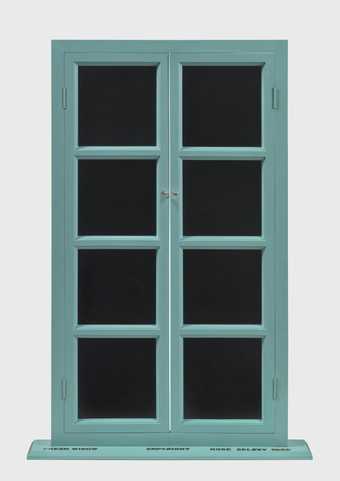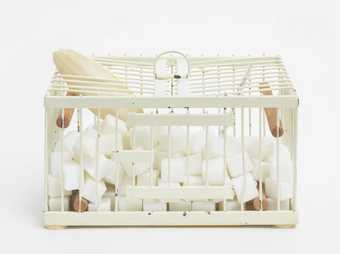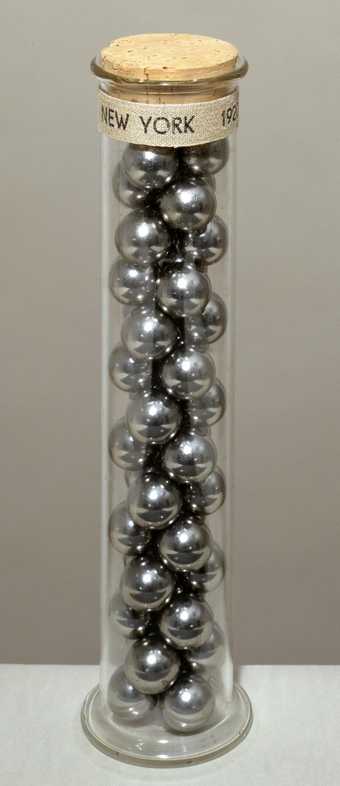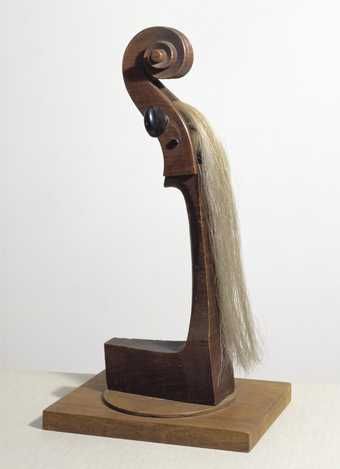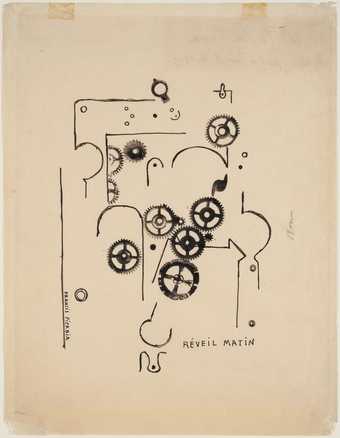
In Tate Modern
- Artist
- Marcel Duchamp 1887–1968
- Medium
- Porcelain
- Dimensions
- Unconfirmed: 360 × 480 × 610 mm
- Collection
- Tate
- Acquisition
- Purchased with assistance from the Friends of the Tate Gallery 1999
- Reference
- T07573
Summary
Fountain is one of Duchamp’s most famous works and is widely seen as an icon of twentieth-century art. The original, which is lost, consisted of a standard urinal, usually presented on its back for exhibition purposes rather than upright, and was signed and dated ‘R. Mutt 1917’. Tate’s work is a 1964 replica and is made from glazed earthenware painted to resemble the original porcelain. The signature is reproduced in black paint. Fountain has been seen as a quintessential example, along with Duchamp’s Bottle Rack 1914, of what he called a ‘readymade’, an ordinary manufactured object designated by the artist as a work of art (and, in Duchamp’s case, interpreted in some way).
Duchamp later recalled that the idea for Fountain arose from a discussion with the collector Walter Arensberg (1878–1954) and the artist Joseph Stella (1877–1946) in New York. He purchased a urinal from a sanitary ware supplier and submitted it – or arranged for it to be submitted – as an artwork by ‘R. Mutt’ to the newly established Society of Independent Artists that Duchamp himself had helped found and promote on the lines of the Parisian Salon des Indépendants (Duchamp had moved from Paris to New York in 1915). The society’s board of directors, who were bound by the Society’s constitution to accept all members’ submissions, took exception to Fountain, believing that a piece of sanitary ware – and one associated with bodily waste – could not be considered a work of art and furthermore was indecent (presumably, although this was not said, if displayed to women). Following a discussion and a vote, the directors present during the installation of the show at the Grand Central Palace (about ten of them according to a report in the New York Herald) narrowly decided on behalf of the board to exclude the submission from the Society’s inaugural exhibition that opened to the public on 10 April 1917. Arensberg and Duchamp resigned in protest against the board taking it upon itself to veto and effectively censor an artist’s work.
This was no small matter. The idea of having a jury-free exhibition of contemporary art had become invested with the aspirations of many in the art world for New York to become a dynamic artistic centre that would rival and even outstrip Paris. Duchamp, as head of the hanging committee, had already signaled the democratic ethos of the new Society by proposing that works should be hung by the artists’ last names (in alphabetical order) rather than according to the subjective views and preferences of one or more individuals. With the support of some backers, he and his close friends Henri-Pierre Roché (1879–1959) and Beatrice Wood (1892–1998) produced the first dada periodical in New York, titled pointedly the Blindman, on the first day of the show in part to celebrate (and in part to observe and comment upon) ‘the birth of the Independence of Art in America’ (Henri-Pierre Roché, ‘The Blind Man’, Blindman, no.1, 10 April 1917, p.3). There was therefore a good deal at stake in the decision of the board to defend a particular conception of art at the expense of departing from its own much advertised policy of ‘no jury – no prizes’. Responding to press interest in the affair, the board issued a statement defending its position: ‘The Fountain may be a very useful object in its place, but its place is not in an art exhibition and it is, by no definition, a work of art.’ (Naumann 2012, p.72.)
Duchamp never explicitly commented on why he wanted to test the principles of his fellow board members but it may well have sprung from his own experience at the Salon des Indépendants in Paris. In 1912 he had submitted his important painting Nude Descending a Staircase, No.2 to the Salon, and, even though the work was listed in the catalogue, the organisers, increasingly unhappy at the subject and title of the painting and how this reflected upon them, asked Duchamp’s brothers, who were also artists, to ask him to withdraw it a few days before the show opened. He quietly did so, but he experienced this as an extraordinary betrayal and later described it as a turning-point in his life. The creation and submission of Fountain can thus be seen as in part as an experiment by Duchamp to replay this event, testing the commitment of the new American Society to freedom of expression and its tolerance of new conceptions of art.
Within a day or so of the exhibition opening, Duchamp located the work, which had been stored in the exhibition space behind a partition, and took it to be photographed by the leading photographer and gallery owner Alfred Stieglitz (1877–1946). (A diary entry of Beatrice Wood for 13 April 1917 recorded that she went with Duchamp to ‘see Stieglitz about “Fountain”’, while a letter written by Stieglitz dated 19 April 1917 noted that he had been asked to take the photograph ‘at the request of Roché, Covert, Miss Wood, Duchamp & Co’. See Naumann 2012, p.72.) As the work of art was lost thereafter (and had been seen by very few people), Stieglitz’s photograph, which according to a letter had been taken by 19 April 1917, became a key document in recording the work’s existence. Stieglitz was proud of the image, writing in a letter dated 23 April 1917, ‘The “Urinal” photograph is really quite a wonder – Everyone who has seen it thinks it beautiful – And it’s true – it is. It has an oriental look about it – a cross between a Buddha and a Veiled Woman’ (Naumann 2012, p.74).
A slightly cropped version of the photograph was published in the Blind Man to illustrate an anonymous editorial that defended the urinal in clear – and, in their implications, revolutionary – terms: ‘Mr Mutt’s fountain is not immoral, that is absurd, no more than a bathtub is immoral. It is a fixture that you see every day in plumbers’ shop windows. Whether Mr Mutt with his own hands made the fountain has no importance. He CHOSE it. He took an ordinary article of life, placed it so that its useful significance disappeared under the new title and point of view – created a new thought for that object.’ (Anon., ‘The Richard Mutt Case’, Blind Man, New York, no.2, May 1917, p.5; note that the second issue formulated the journal’s title as separate words.) Duchamp later said that he shared and approved of the views expressed in the article, which Beatrice Wood claimed in her 1992 autobiography to have written.
Importantly, Duchamp was not publicly known as the creator of Fountain at the time, although some of his closest friends (such as Walter Arensberg) must have known of, and many others suspected, his involvement. Stieglitz, for example, wrote on 19 April 1917, ‘a young Woman (probably at Duchamp’s instigation) sent a large porcelain Urinal on a pedestal to the Independent[s]’ (Naumann 2012, p.74.) Duchamp later explained that he had not made his identity known because of his position on the Society’s board: if his fellow board members had known he had submitted Fountain, their response might well have been different, and he would have been shown to have put friends and colleagues in a potentially difficult position (which, indeed, was the case). The fact that ‘R. Mutt’ was an unknown artist meant that Duchamp could test the openness of the society to artworks that did not conform to conventional aesthetic and moral standards without compromising the outcome or his relationships with board members, though at the expense of being able to avow that the work was his own.
‘R. Mutt’, however, was an unusual name, with comic overtones, and this might have given people a clue as to its falseness. Later in life, when asked whether ‘R. Mutt’ was a pun on the German word Armut meaning poverty, Duchamp was quoted as explaining:
Mutt comes from Mott Works, the name of a large sanitary equipment manufacturer. But Mott was too close so I altered it to Mutt, after the daily cartoon strip “Mutt and Jeff” which appeared at the time, and with which everyone was familiar. Thus, from the start, there was an interplay of Mutt: a fat little funny man, and Jeff: a tall thin man ... I wanted any old name. And I added Richard [French slang for money-bags]. That’s not a bad name for a pissotière. Get it? The opposite of poverty. But not even that much, just R. MUTT.
(Camfield 1989, p.23.)
In fact, Mutt was the tall thin man in the cartoon duo but Duchamp’s point about having wanted essentially ‘any old name’ remains. On other occasions Duchamp recalled that he bought the urinal at J.L. Mott Iron Works Company. Surviving records for the sanitary ware firm are incomplete but show models similar, if not entirely identical, to Fountain (see Camfield 1989, p.24, note 23).
Duchamp never commented – or was asked to comment – upon the rotation of the urinal by ninety degrees, but this was perhaps dealt with in the anonymous Blind Man article as a matter of ‘placing’ it ‘so that its useful significance disappeared under the new title and point of view’. Duchamp was fascinated by the problems of representing spatially a fourth dimension, often demonstrated in mathematical texts through diagrams showing the rotation of solids. It is possible that the rotation of the urinal was linked to his broader interest in seeing things quite literally in a new perspective. The intimate nature of the function of the urinal, and its highly gendered character, also resonated strongly with the complex psycho-physical themes of the masterpiece he was working on at the time, The Bride Stripped Bare by her Bachelors, Even 1915–23 (also known as The Large Glass; see Tate T02011), although relatively few at the time knew of the unfinished work and, therefore, were able to make this association.
Several photographs believed to have been taken in 1918 show Fountain hanging in the doorway of Duchamp’s studio (there is no reason to believe that Duchamp owned a second or different urinal), but what happened to the artwork thereafter is a mystery. It was possibly thrown out when Duchamp went to Buenos Aires in 1918, the year that the poet Guillaume Apollinaire wrote an article on the Richard Mutt affair for the Mercure de France. Focusing on the issues involved in the case (and not mentioning Duchamp by name), Apollinaire concluded, ‘The viewpoint of the Society of Independent Artists is evidently absurd for it arises from the untenable point of view that art cannot enoble an object’ (Naumann 2012, p.75).
In the early 1920s Duchamp travelled frequently between America and France. He was thought to have abandoned making art, focusing instead on playing chess competitively even while remaining part of artistic circles. Fountain was not publicly commented upon again until 1934 when the leader of the surrealist movement and poet André Breton wrote a pioneering article that reviewed Duchamp’s career to date and placed the Fountain firmly in the context of Duchamp’s readymades (André Breton, ‘La Phare de la mariée’, Minotaure, vol.2, no.6, 1935, pp.45–9). Since so little was published on Duchamp, the article seems to have been based on in-depth conversations with the artist. It was in this period that Duchamp felt the need to consolidate and make more accessible his otherwise dispersed (and already partly lost) oeuvre. He published a facsimile edition of his notes relating to the Large Glass, and produced a portable museum of his key works in an editioned box, titled Box in a Valise (From or by Marcel Duchamp or Rrose Sélavy) 1935–41 (Rrose Sélavy was the name of Duchamp’s female alter ego). In this he included a miniature Fountain arranged next to an equally miniature Large Glass, the lower half of which is known as the ‘bachelors’ domain’.
Duchamp’s profile in art circles rose dramatically in the 1950s and 1960s, not least as a new generation of artists identified his dada-period works as precedents for their own. In 1963 the Pasadena Art Museum organised the first retrospective of Duchamp’s work. Addressing the growing number of requests from gallerists and museums for works to show, Duchamp authorised a number of replicas of his original readymades, many of which had been lost. He authorised replicas of Fountain in 1950 and 1963. In 1964 the Galleria Schwarz reproduced Fountain, along with other dada-period works by Duchamp, in an edition of eight, fabricating the objects on the basis on the Stieglitz photograph and working closely with Duchamp. Four further examples were also made at this time, one each for Duchamp and Arturo Schwarz, and two for museum exhibition. Duchamp signed each of these replicas on the back of the left flange ‘Marcel Duchamp 1964’. There is also a copperplate on the base of each work etched with Duchamp’s signature, the dates of the original and the replica, the title, the edition number and the publisher’s name, ‘Galleria Schwarz, Milan’. For some, such replicas seemed to undermine cardinal qualities of readymades, namely, that they should be mass-produced items and ones chosen by an artist at a particular moment and time. Duchamp, however, was happy to remove the aura of uniqueness surrounding the original readymades, while the production of replicas ensured that more people would see the works and increased the likelihood that the ideas they represented would survive.
Tate’s replica was included in the inaugural displays of Tate Modern in 2000, and in 2004 Fountain topped a poll of 500 British art experts as the single most influential artwork of the twentieth century, ahead of Picasso’s Les Demoiselles d’Avignon 1907 and Andy Warhol’s Marilyn Diptych 1962. Simple in form but rich in metaphor, the work has generated many interpretations over the years, and continues to be seen as a work that challenges – or, at the least, complicates – conventional definitions of art. In his introduction to his 1989 book-length study of the work William Camfield acknowledged the ‘staggering’ quantity of material written about the piece but noted that, despite the wealth of scholarship,
an examination of this literature reveals that our knowledge of this readymade sculpture and its history is riddled with gaps and extraordinary conflicts of memory, interpretation, and criticism. We are not even able to consult the object itself, since it disappeared early on, and we have no idea what happened to it … We do not even known with absolute certainty that Duchamp was the artist – he once attributed it to a female friend – and some of his comments raise fundamental questions regarding his intentions in this readymade.
(Camfield 1989, p.13.)
Camfield’s reference to a female friend here was based on a letter Duchamp wrote to his sister Suzanne, who lived in Paris, on 11 April 1917. It included the following comment: ‘One of my female friends under a masculine pseudonym, Richard Mutt, sent in a porcelain urinal as a sculpture; it was not at all indecent – no reason for refusing it. The committee has decided to refuse to show this thing. I have handed in my resignation and it will be a bit of gossip of some value in New York.’ (Camfield 1989, p.28.) Camfield commented on this reference to a woman:
Even if we grant that he did not want his test of the Independents compromised by knowledge that Fountain had been submitted by a director of the organization, why did he mislead his sister in Paris? Was the account given to Suzanne merely a ‘white lie’ to conceal his authorship, or might we have here an early appearance of Duchamp’s female alter ego Rrose Sélavy, or might he have been telling the truth? Was Fountain actually submitted by a female friend? And if, indeed, a female friend sent Fountain to the Independents, must that mean that she and not Duchamp was the artist who conceived, selected, and altered the urinal – or might she have acted merely as the shipping agent whose participation kept Duchamp out of sight? The last possibility seems most plausible, but this point remains a mystery.
As Camfield noted, there are several potential explanations for Duchamp’s comment to his sister. Unfortunately, the records of the Society of Independent Artists are of no help here, as most were lost in a fire. It is important to note, however, that Duchamp wrote ‘sent’ not ‘made’, and his words do not indicate that he was implying that someone else was the work’s creator.
In 2002 literary historian Irene Gammel claimed that, if a woman was involved in the submission of Fountain, that woman might have Baroness Elsa von Freytag-Loringhoven (1874–1927), an eccentric German poet and artist who loved Duchamp and was in turn jealous of him and mildly contemptuous of what she saw as his absorption in fashionable circles (see Irene Gammel, Baroness Elsa: Gender, Dada, and Everyday Modernity. A Cultural Biography, Cambridge, Massachusetts 2002). Gammel explored the possibility that the Baroness was the creator of Fountain, claiming close affinities between the use of new sanitary ware in Fountain and of an old piece of plumbing (a plumbing trap), mounted on a carpenter’s mitre box in a sculpture titled God that has been attributed to the Baroness. This unsigned work, now in the Philadelphia Museum of Art, was originally thought to be by the painter Morton Schamberg on the basis of his photograph of it, but was reattributed by the scholar Francis M. Naumann to von Freytag-Loringhoven ‘with’ Schamberg, on the grounds that the assemblage of extraneous elements and unusual title probably fitted her artistic practice better than his, although he may have helped her with aspects of it (for a discussion of the documentary evidence supporting this reattribution see Francis M. Naumann, New York Dada 1915–23, New York 1994, p.128 note 9, p.234 and p.171.) The work’s aesthetic, however, is far removed from the mass-produced aspect of Fountain, and there is nothing in von Freytag-Loringhoven’s other works to suggest a lineage for the thinking expressed in Fountain. Gammel noted that von Freytag-Loringhoven was in Philadelphia in spring 1917, linking this to some unsourced press reports at the time of the scandal of the work having originated in Philadelphia, and concluded, ‘there emerges the question of whether the rabble-rousing Baroness may have had a hand in the mysterious Fountain … While final evidence of the Baroness’s involvement may be missing, there is a great deal of circumstantial evidence that points to her artistic fingerprint’ (Gammel 2002, p.225).
As Gammel acknowledged, however, there is no contemporary documentary evidence or testimony that points to the involvement of von Freytag-Loringhoven in Fountain. The Baroness, who was certainly not shy of controversy, seems never to have claimed to have been involved, even when she returned to New York and mixed in the same circles as Duchamp (she later modelled nude for a film he attempted to make with Man Ray), and it seems improbable that she would have not have vaunted her creation of a work that had caused such a flurry of press interest, particularly if it was associated in many people’s minds with Duchamp. It perhaps should be noted that Duchamp spent much of his life quietly helping many other artists, and any suggestion that he would claim the work of another as his own runs completely counter to the high esteem in which he was held by artist friends. When he discussed his work with Breton in 1935, it seems improbable that he would have risked claiming Fountain to be part of his oeuvre at a time when so many who had been in New York in 1917 (and who also knew von Freytag-Loringhoven) would have been able to contradict him, had his authorship been in doubt in any way.
One such person was Man Ray, who had been on the organising committee of the Society of Independent Artists in 1917 and knew von Freytag-Loringhoven. In 1945, however, Man Ray referred in print to the story of Fountain without any qualification in an article he published in View magazine about his long friendship with Duchamp. Remembering how in 1917 Duchamp recovered Fountain from the Grand Central Palace where it had been temporarily stored behind a partition, he wrote: ‘Grand Central: The very independent Richard Mutt robbed the vestals of their vespasienne in broad daylight and called it another day.’ (Man Ray, ‘Bilingual Biography’, View, vol.5, no.1, March 1945, p.32.) To reflect the playful, transatlantic nature of their friendship, Man Ray used enigmatic phrasing that mixed French and English throughout the text. Here he used the French word vespasienne, meaning a structure or partition surrounding a urinal, for Fountain and talked alliteratively about ‘vestals’ (in classical times the guardians of the temple) to refer to those who were meant to guard the contents of the exhibition from such incursions. Having found where the piece was hidden, Duchamp had presumably been able to walk out of the Grand Central Palace with Fountain because none of the guards thought it an artwork.
As for the possible role of a woman in the work’s submission, it is known from a careful decipherment of the address label that hangs from the urinal in Stieglitz’s photograph that a woman was indeed implicated, though not as the creator of the piece. The details were those of Louise Norton (1890–1989), one of Duchamp’s closest friends at the time and the author of a discursive article about the Fountain called ‘“Buddha of the Bathroom”’ that appeared in the second issue of the Blind Man. (‘To those who say Mr. Mutt’s exhibit may be Art, but is the art of Mr. Mutt since a plumber made it? I reply simply that the Fountain was not made by a plumber but by the force of an imagination; and of imagination it has been said, “All men are shocked by it and some overthrown by it.”’ She added, ‘there are those who anxiously ask, “Is he serious or is he joking?” Perhaps he is both! Is it not possible? … there is among us to-day a spirit of blague [joke] arising out of the artist’s bitter vision of an over-institutionalized world of stagnant statistics and antique axioms.’ Louise Norton, ‘“Buddha of the Bathroom”’, Blind Man, no.2, May 1917, p.6.) Significantly, in the days that followed the decision not to exhibit the Fountain the artist Charles Demuth wrote to Henry McBride, the art critic of the Sun, saying that the piece had been submitted ‘by one of our friends’ and asking if McBride would consider writing about the affair to give it more publicity. He added: ‘P.S. If you wish any more information please phone, Marcel Duchamp, 4225 Columbus, or, Richard Mutte, 9255 Schuyler’ (Camfield 1989, p.30). The telephone number given for the misspelt Richard Mutt was again that of Louise Norton. Although interviewed about Fountain late in her life, Louise Norton (or Louise Varèse, as she became) did not provide any new information about her involvement, and today nothing is known why her address appears on the label attached to Fountain or why her number was given to a journalist where information about Richard Mutt might be had. The gaps in knowledge about the details of her involvement in the submission of the piece to the society and its defence to the press do not materially affect Fountain’s status or meaning, but her role is a reminder of how in New York in spring 1917 Duchamp was not alone in seeking changes in how art was then thought of and practised.
Fountain tested beliefs about art and the role of taste in the art world. Interviewed in 1964, Duchamp said he had chosen a urinal in part because he thought it had the least chance of being liked (although many at the time did find it aesthetically pleasing). He continued: ‘I was drawing people’s attention to the fact that art is a mirage. A mirage, exactly like an oasis appears in the desert. It is very beautiful until, of course, you are dying of thirst. But you don’t die in the field of art. The mirage is solid.’ (Otto Hahn, ‘Entretien Marcel Duchamp’, Paris-Express, 23 July 1964, p.22.) Extensively studied and the subject of various interpretations, Fountain has continued to exert an extraordinary power over narratives of twentieth-century art in large part because of its piercing – if also humorous – questioning of the structures of belief and value associated with the concept of art.
Further reading
William Camfield, Marcel Duchamp: Fountain, Houston 1989.
Arturo Schwarz, The Complete Works of Marcel Duchamp, revised and expanded edition, New York 1997, pp.648–50.
Francis M. Naumann, The Recurrent, Haunting Ghost: Essays on the Art, Life and Legacy of Marcel Duchamp, New York 2012, pp.70–81.
Sophie Howarth
April 2000
Revised Jennifer Mundy
August 2015
Does this text contain inaccurate information or language that you feel we should improve or change? We would like to hear from you.
Display caption
Fountain is Duchamp’s most famous work. It is an example of what he called a ‘ready-made’ sculpture. These were made from ordinary manufactured objects. He then presented them as artworks. This invites us to question what makes an object ‘art’? Is this urinal ‘art’ because it is being presented in a gallery? The original 1917 version of this work has been lost. This is one of a small number of copies that Duchamp allowed to be made in 1964. Do you think it makes a difference that it is not Duchamp’s original urinal?
Gallery label, July 2020
Does this text contain inaccurate information or language that you feel we should improve or change? We would like to hear from you.
Technique and condition
This replica is one of at least ten made in 1963/64 by the artist’s dealer, Arturo Schwartz. The prototype for the replica was developed from technical drawings and modelled in clay (drawings and model are owned by the Philadelphia Museum of Art). The replicas were probably manufactured in Europe by a sanitary ware manufacturer using a conventional slip-cast technique. The sculpture appears to be a hollow fired clay construction with a bluish white glaze typical of mass produced urinals. However the glaze does not appear to have been satisfactory and all the replicas were painted a dense white. The ‘R. Mutt, 1917’ inscription was reproduced in gloss black paint.
Prior to acquisition the sculpture was found to have been further over painted to disguise damage to one ‘wing’. Subsequent investigation showed that original paint layers, including a grey alkyd primer and titanium white alkyd top coat, were still present under several alternating layers of nitrocellulose paints and varnishes. These layers were identified by conservation scientist, Tom Learner, using PyGCMS and FTIR as part of the restoration treatment completed by Flavia Perugini in January 2000.
The underside of the sculpture is signed by the artist across the broken wing. A lacquered copper plate with engraved edition details is adhered to the centre of the underside. A similar plate was fixed to all replicas editioned at this time.
Flavia Perugini / Derek Pullen
April 2000 / October 2004
Film and audio
Features
-
Tate Etc
Explore
- architecture(30,960)
-
- garden structures(1,939)
-
- fountain(177)
- formal qualities(12,454)
-
- found object / readymade(2,631)
- humour(1,441)
- pun(53)
- transformation(186)
- furnishings(3,081)
-
- urinal(2)
You might like
-
Othon Friesz Woman at a Window
1919 -
Marcel Duchamp The Bride Stripped Bare by her Bachelors, Even (The Large Glass)
1915–23, reconstruction by Richard Hamilton 1965–6, lower panel remade 1985 -
Marcel Duchamp Coffee Mill
1911 -
Francis Picabia The Fig-Leaf
1922 -
Marcel Duchamp Female Fig Leaf
1950, cast 1961 -
Marcel Duchamp Dart Object
1951, cast 1962 -
Marcel Duchamp Fresh Widow
1920, replica 1964 -
Marcel Duchamp 3 stoppages étalon (3 Standard Stoppages)
1913–14, replica 1964 -
Marcel Duchamp Why Not Sneeze Rose Sélavy?
1921, replica 1964 -
Marcel Duchamp The Bride Stripped Bare by her Bachelors Even (The Green Box)
1934 -
Man Ray New York
1920, editioned replica 1973 -
Man Ray Cadeau
1921, editioned replica 1972 -
Man Ray L’Enigme d’Isidore Ducasse
1920, remade 1972 -
Man Ray Emak Bakia
1926, remade 1970 -
Francis Picabia Alarm Clock
1919

